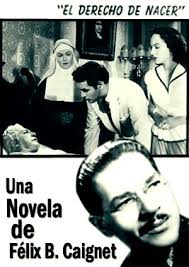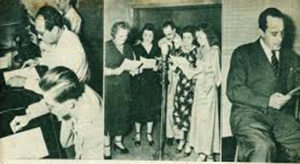 HISTORIA DE LA RADIO NOVELA Y TELENOVELA CUBANA.
HISTORIA DE LA RADIO NOVELA Y TELENOVELA CUBANA.
Aunque podría hablarse de algunos intentos anteriores –a partir de 1919- la radio cubana nació en 1922. El 10 de octubre de ese año, Alfredo Zayas y Alfonso, Presidente de la República de Cuba, inauguraba la radio cubana con un discurso que pronunció… en inglés. Lo hizo desde los micrófonos de una poderosa emisora de 500 watts, instalada en la sede de la Compañía Cubana de Teléfonos, subsidiaria de la ITT. Era la primera emisora norteamericana en la América Latina, y surgió, se dijo, con un carácter “experimental”.
Poco después, de una primitiva red de radioaficionados, surgieron emprendedores animosos que sembraron la Isla de emisoras pequeñas. En 1933 había en Cuba 62 radioemisoras que situaban al país, en este campo, a la cabeza del continente, solo superado por Estados Unidos y Canadá. En Uruguay había entonces 25 estaciones de radio, 22 en Brasil y 17 en la Argentina.
“El factor cuantitativo, determinante en este caso, marcó la tónica y el estilo de las audiciones. Con rapidez, desde el principio, en música, en chispazos humorísticos, en declamaciones y noticias, se impusieron las preferencias nacionales” –afirmaba Iris Dávila.
LA NOVELA RADIAL O RADIONOVELA.
Nadie hablaba de “radionovela” ni de “novela radial” hasta que los cubanos inventamos dichos términos, y lo mismo sucedió con el de “telenovela”. Inventamos los términos porque antes habíamos inventado el producto. De ahí que una famosísima radionovelista de ayer, Iris Dávila, expresara hace años que los cubanos son los culpables de un hecho literario unido por el cordón umbilical a la tecnología del siglo XX y causante de no pocas polémicas en los círculos intelectuales de la América Latina. Aludía, por supuesto, a la narrativa transformada y expandida primero por la radio y luego por la televisión.
En Estados Unidos, mientras tanto, había surgido un producto radiofónico eficaz: la soap opera. Existía allí un vivo interés por lanzarlo en la América Latina, pero esperaban hacerlo en el momento propicio. Se necesitaba antes, como plataforma, inundar de aparatos receptores perfeccionados las vastas regiones del continente y asegurar así la utilidad del negocio.
En Cuba, sin embargo, se iba ganando terreno, acaso por intuición, en cuanto a los contenidos radiofónicos afines a una gran masa de oyentes. Y ya en 1934 asoma aquí la radionovela. Nace en una emisora de la ciudad de Santiago de Cuba y tiene como protagonista a Chan Li Po, un detective chino que haría célebre su frase de “Paciencia, mucha paciencia”. Su creador es Félix Benjamín Caignet Salomón.
Pero Caignet no partió de la nada. Otros autores le abonaron el camino.
POR LOS CAMINOS DE LA RADIODIFUSIÓN CUBANA.
Ya en 1929 se decían versos y monólogos por la radio cubana, y en 1931 se radió por primera vez algo muy parecido a una novela amorosa: su autor fue el célebre poeta José Ángel Buesa. A partir de ahí gana fuerza el radioteatro, dramatizaciones que contemplaban los ingredientes –música y efectos sonoros- de lo que después se llamaría el lenguaje radial. Y por esa misma época el propio Caignet, basándose en un recuerdo de su niñez, el de los cuenteros populares, introdujo el suspenso en un programa infantil que escribía entonces: cortaba la narración en un momento culminante de la trama y había que esperar al capítulo siguiente para enterarse de cómo proseguía la acción.
En ese entonces Caignet estaba estrenando, en Santiago de Cuba, la primera serie de su Chan Li Po. En 1937 viene a La Habana y logra un contrato en una emisora de segunda fila. Pero allí duraría poco tiempo; una emisora poderosa lo ficha y trasmite durante unos ocho años consecutivos las sutiles deducciones del detective despejador de crímenes e incógnitas que complace a un auditorio cada vez más mayoritario.
La radionovela del corazón propiamente dicha surgió en 1941, cuando la RHC Cadena Azul inicia su espacio La Novela del Aire. El primer título original cubano en esa línea es Por la ciudad rueda un grito, de Reynaldo López del Rincón, adaptador hasta entonces de grandes novelas. López del Rincón, con su obra, hizo zafra de público e inauguró toda una etapa.
En 1944 Caignet estrena ‘El precio de una vida’, y, dos años después, con ‘Peor que las víboras’ ratifica su popularidad. Ya en 1945 aparece ‘El collar de las lágrimas’, de Pepito Sánchez Arcilla, que con sus 965 capítulos es la novela más larga que ha trasmitido la radio cubana en toda su historia. En 1946 salían al aire aquí entre 25 y 30 radionovelas diarias. En 1948 se radia ‘El derecho de nacer’, y su autor, Félix B. Caignet, se sitúa a la cabeza de los escritores del género.
En ese periodo surgen, entre otros, los nombres imprescindibles de Iris Dávila, Hilda Morales, Caridad Bravo Adams, Dora Alonso, René Alouis, Aleida Amaya… que acaparan, cada uno de ellos con estilo propio, el favor de radioescuchas cubanos y de otras latitudes pues no era extraño que sus obras se trasmitiesen en diez o doce naciones.
En los años 50s despunta la telenovela nuestra –precisaba Iris Dávila. Considerada globalmente semejante vitalidad implica una dinámica creativa desmesurada y vertiginosa, de extraordinario relieve sociológico en el contexto cultural cubano de la década de los 50. Creando una gigantesca ola de triunfos y progreso cultural en nuestra nación.
El hombre común sigue necesitado de verse realizado en un proyecto ajeno triunfante. Se dice que quien escucha o ve un folletín, no ve ni oye una novela, sino que visita una casa en la que ocurren cosas más interesantes que en la propia. Convierte al espectador en un chismoso: sabe cosas que el protagonista desconoce y quiere gritárselas desde su sala y juega así un papel dentro de esa trampa que es la trama del folletín.
 HISTORY OF THE RADIO AND TELENOVELA CUBANA.
HISTORY OF THE RADIO AND TELENOVELA CUBANA.
Although one could speak of some previous attempts -from 1919- the Cuban radio was born in 1922. On October 10 of that year, Alfredo Zayas y Alfonso, President of the Republic of Cuba, inaugurated the Cuban radio with a speech that he pronounced … in English. He did it from the microphones of a powerful 500-watt transmitter, installed at the headquarters of the Cuban Telephone Company, a subsidiary of ITT. It was the first North American station in Latin America, and it emerged, it was said, with an “experimental” character.
Shortly afterwards, from a primitive network of radio amateurs, game entrepreneurs emerged who planted the island with small stations. In 1933 there were 62 radio stations in Cuba that placed the country, in this field, at the head of the continent, second only to the United States and Canada. In Uruguay there were then 25 radio stations, 22 in Brazil and 17 in Argentina.
“The quantitative factor, which was decisive in this case, set the tone and style of the auditions, quickly, from the beginning, in music, in humorous flashes, in declamations and news, national preferences were imposed,” affirmed Iris Dávila.
THE NOVELA RADIAL OR RADIONOVELA.
No one spoke of “radionovela” or “radio novel” until we Cubans invented such terms, and the same thing happened with “telenovela”. We invented the terms because before we had invented the product. That is why a famous radio soap opener yesterday, Iris Dávila, expressed years ago that Cubans are guilty of a literary event linked by the umbilical cord to twentieth century technology and cause not a few controversies in the intellectual circles of Latin America . He alluded, of course, to the narrative transformed and expanded first by radio and then by television.
In the United States, meanwhile, an effective radio product had emerged: soap opera. There was a lively interest in launching it in Latin America, but they hoped to do so at the right time. It was necessary before, as a platform, to flood of perfected receptive apparatuses the vast regions of the continent and to assure therefore the utility of the business.
In Cuba, however, it was gaining ground, perhaps by intuition, in terms of radio content related to a large mass of listeners. And already in 1934 the radio soap opera appears here. Born in a radio station in the city of Santiago de Cuba and has as protagonist Chan Li Po, a Chinese detective who would make famous his phrase “Patience, a lot of patience”. Its creator is Felix Benjamín Caignet Salomón.
But Caignet did not start from nothing. Other authors paid him the way.
ON THE ROADS OF CUBAN BROADCASTING.
Already in 1929 verses and monologues were said on Cuban radio, and in 1931 something very similar to a love novel was broadcast for the first time: its author was the famous poet José Ángel Buesa. From there the radio drama gained strength, dramatizations that contemplated the ingredients – music and sound effects – of what would later be called radial language. And around the same time, Caignet himself, based on a childhood memory, that of the popular storytellers, introduced the suspense in a children’s program that he wrote at the time: he cut the narrative at a culminating moment in the plot and had to wait for the chapter next to find out how the action continued.
At that time Caignet was premiering, in Santiago de Cuba, the first series of his Chan Li Po. In 1937 he came to Havana and obtained a contract in a second-tier station. But there it would last a short time; a powerful station transmits it and transmits for eight consecutive years the subtle deductions of the detective of crimes and unknowns that pleases an increasingly larger audience.
The radionovela of the heart proper arose in 1941, when the RHC Cadena Azul starts its space La Novela del Aire. The first original Cuban title in that line is By the city rolls a scream, Reynaldo López del Rincón, adapter until then of great novels. López del Rincón, with his work, made public harvest and inaugurated a whole stage.
In 1944 Caignet premiered ‘The price of a life’, and, two years later, with ‘Peor que las viboras’ confirms its popularity. Already in 1945 appears ‘The necklace of tears’, by Pepito Sanchez Arcilla, which with its 965 chapters is the longest novel that has been broadcast by Cuban radio in all its history. In 1946 between 25 and 30 radio soap operas a day appeared here. In 1948 the right to be born was broadcast, and its author, Felix B. Caignet, is at the head of the writers of the genre.
In that period arise, among others, the essential names of Iris Dávila, Hilda Morales, Caridad Bravo Adams, Dora Alonso, René Alouis, Aleida Amaya … who monopolize, each with their own style, the favor of Cuban radio listeners and others latitudes then it was not strange that his works were transmitted in ten or twelve nations.
In the 50s, the soap opera is breaking, “said Iris Dávila. Considered globally such vitality implies a disproportionate and vertiginous creative dynamic, of extraordinary sociological relief in the Cuban cultural context of the 50s. Creating a gigantic wave of triumphs and cultural progress in our nation.
The common man still needs to be realized in a triumphant alien project. It is said that whoever listens or watches a soap opera, does not see or hear a novel, but visits a house in which more interesting things happen than in their own. It turns the spectator into a gossip: he knows things that the protagonist does not know and he wants to scream at them from his living room and thus plays a role within that trap that is the plot of the serial.
Agencies/ Ciro Bianchi / Internet Photos/ Extractos/ YouTube/ Arnoldo Varona/ thecubanhistory.com
THE CUBAN HISTORY, HOLLYWOOD.








